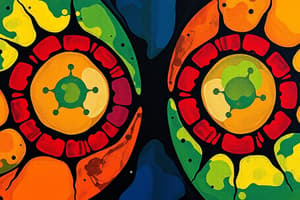Podcast
Questions and Answers
What is a characteristic feature of cancer cells in terms of their growth?
What is a characteristic feature of cancer cells in terms of their growth?
- They undergo apoptosis more frequently than normal cells.
- They respond strictly to regulatory mechanisms.
- They grow in a controlled fashion similar to normal cells.
- They proliferate despite the presence of regulators and checkpoints. (correct)
Which of the following describes the role of negative regulators in the cell cycle?
Which of the following describes the role of negative regulators in the cell cycle?
- They have no significant impact on cancer cell behavior.
- They enhance the function of cyclins and CDKs.
- They halt the cell cycle and prevent progression when necessary. (correct)
- They promote cell division during all phases.
What is the purpose of internal control mechanisms in the cell cycle?
What is the purpose of internal control mechanisms in the cell cycle?
- To avoid mistakes that could be inherited by daughter cells. (correct)
- To increase hormone release during cell division.
- To ensure errors are passed on to daughter cells.
- To enable faster cell division.
What triggers the release of hormones like HGH in relation to cell growth?
What triggers the release of hormones like HGH in relation to cell growth?
Which of the following is NOT a characteristic of cancer cells?
Which of the following is NOT a characteristic of cancer cells?
What is the primary function of the G1/S checkpoint in the cell cycle?
What is the primary function of the G1/S checkpoint in the cell cycle?
What occurs during the S Phase of interphase?
What occurs during the S Phase of interphase?
In which phase of mitosis do chromosomes align at the cell's equator?
In which phase of mitosis do chromosomes align at the cell's equator?
What is the role of the Spindle Assembly Checkpoint (SAC)?
What is the role of the Spindle Assembly Checkpoint (SAC)?
What major event occurs during telophase in animal cells?
What major event occurs during telophase in animal cells?
During which phase does the nuclear envelope begin to re-form?
During which phase does the nuclear envelope begin to re-form?
What initiates or inhibits cell division based on external conditions?
What initiates or inhibits cell division based on external conditions?
What happens during Anaphase as sister chromatids separate?
What happens during Anaphase as sister chromatids separate?
What are the primary types of cells produced via mitosis?
What are the primary types of cells produced via mitosis?
During which phase of the cell cycle does DNA synthesis occur?
During which phase of the cell cycle does DNA synthesis occur?
Which of the following best describes the number of chromosomes in mitotic cells compared to parent cells?
Which of the following best describes the number of chromosomes in mitotic cells compared to parent cells?
What is the significance of mitosis in multicellular organisms?
What is the significance of mitosis in multicellular organisms?
Which term describes the two identical halves of a chromosome?
Which term describes the two identical halves of a chromosome?
What is the configuration of chromosomes before DNA synthesis as noted in the content?
What is the configuration of chromosomes before DNA synthesis as noted in the content?
In which phase of mitosis do the chromosomes align at the cell’s equatorial plate?
In which phase of mitosis do the chromosomes align at the cell’s equatorial plate?
What type of cells result from meiosis, as opposed to mitosis?
What type of cells result from meiosis, as opposed to mitosis?
What is the total number of chromatids present after mitosis if the original diploid number is 6?
What is the total number of chromatids present after mitosis if the original diploid number is 6?
Which statement is true regarding the cell cycle?
Which statement is true regarding the cell cycle?
Flashcards are hidden until you start studying
Study Notes
Cell Cycle Overview
- The cell cycle consists of sequential phases leading to cell growth and division.
- Key phases include Interphase (G1, S, G2) and Mitosis (Prophase, Metaphase, Anaphase, Telophase).
Phases of Interphase
- G1 Phase: Growth and development; cells increase in size and synthesize proteins.
- S Phase: DNA synthesis occurs; chromosomes are replicated.
- G2 Phase: Cell prepares for mitosis; checks for DNA replication errors.
- G0 Phase: Resting phase where the cell is metabolically active but not preparing to divide.
Phases of Mitosis
- Prophase: Chromatin condenses into visible chromosomes; nuclear membrane and nucleolus disintegrate; centrioles move to opposite poles.
- Metaphase: Chromosomes line up along the cell's equatorial plane; spindle fibers attach to kinetochores on sister chromatids.
- Anaphase: Sister chromatids split and are pulled towards opposite poles; cell elongates.
- Telophase: Nuclear envelopes reform around each set of chromosomes; chromosomes decondense back to chromatin; cytokinesis occurs, resulting in two daughter cells.
Mitosis vs. Meiosis
- Mitosis produces diploid (2n) body cells; DNA content remains constant pre- and post-division.
- Meiosis produces haploid (n) gametes (sperm and egg); involves two rounds of division, resulting in genetic variation.
DNA Packaging
- Chromosomes consist of two sister chromatids linked at a centromere.
- In humans, 46 chromosomes (23 pairs) are present in somatic cells; during mitosis, the chromosome count remains constant.
Cell Cycle Regulation
- Cell division is regulated by external factors (e.g., hormone release, cell size, neighboring cell death).
- Internal checkpoints ensure accurate division; key checkpoints include G1/S, G2/M, and the Metaphase spindle assembly checkpoint (SAC).
Molecule Regulators
- Positive Regulators: Include cyclins and cyclin-dependent kinases (CDKs) that promote progression through the cell cycle.
- Negative Regulators: Proteins such as retinoblastoma protein (Rb), p53, and p21; dysfunctional in cancer cells.
Cancer Characteristics
- Clonality: Genetic changes accumulate over time in cancer cells.
- Autonomy: Cancer cells can proliferate uncontrollably, ignoring regulatory mechanisms.
- Anaplasia: Display abnormal morphology; often have large, irregular nuclei.
- Angiogenesis: Formation of new blood vessels to supply tumors.
Conclusion
- Mitosis ensures equal distribution of genetic information to daughter cells, while its regulation is crucial in maintaining cellular integrity and preventing cancerous growths.
Studying That Suits You
Use AI to generate personalized quizzes and flashcards to suit your learning preferences.




